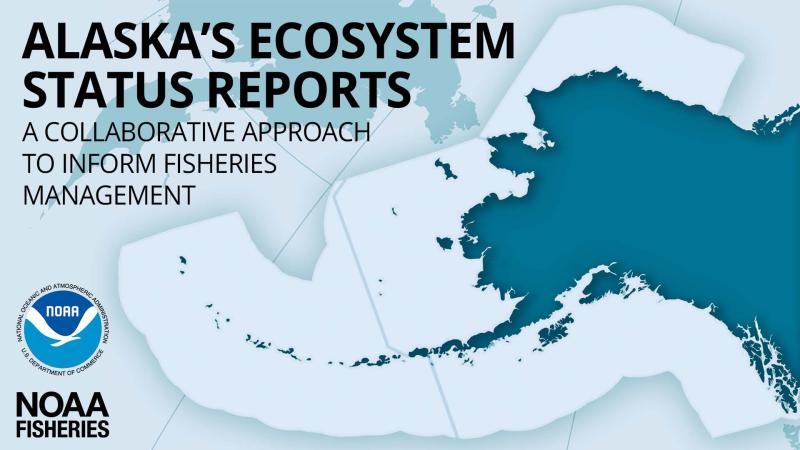Today, NOAA Fisheries released three key reports on the state of Alaska’s marine ecosystems. For more than two decades, Alaska has been using this ecosystem information to inform fisheries management decisions. To assess the status of Alaska’s marine ecosystems, scientists look at a variety of indicators.
For instance, they monitor oceanographic conditions. These include sea surface temperatures and temperatures near the sea floor, plankton, and wind and weather patterns in the Bering Sea, Gulf of Alaska, and Aleutian Islands annually and over time.
Scientists examine abundance trends (whether increasing or decreasing over time) of groundfish and crab predators and prey in these marine ecosystems. They also look at the condition of marine life at different stages of their lives including zooplankton (tiny animals that form the base of the marine food chain). They examine fish such as pollock in their first year of life and juvenile salmon. Scientists also evaluate how fat marine animals are. This provides an indication of whether they will survive Alaska’s cold winter or their migration to winter grounds.
Scientists also assess survival rates for the young of many species to better understand, for example, how many larval fish make it to adulthood, how many seabird eggs successfully hatch, and how many sea lion or fur seal pups survive.
The reports also integrate data across multi-year trends to place current year observations in a broader context.
Overall 2021 Highlights
-
The Gulf of Alaska has been in transition since the 2014–2016 and 2019 marine heatwave periods, with some marine populations decreasing and others increasing;
-
The Bering Sea has experienced cumulative impacts of sustained warm conditions
-
The Aleutian Islands have experienced sustained warm conditions since 2013 and the combined biomass of Pacific ocean perch and northern rockfish is now higher than that of Atka mackerel and pollock, which used to be the dominant pelagic foragers
Eastern Bering Sea
The Eastern Bering Sea has been in a persistent warm phase since around 2014. Sea surface temperatures were higher than the average from 1985–2014.
Temperatures near the seafloor in northern Bering Sea coastal waters were very warm with a small area of cold water (i.e., the “cold pool”) to the southwest of St. Lawrence Island. In 2021, the size of the cold pool was the fourth lowest on record. The southern shelf had moderately warm bottom waters
Fall 2020 sea ice formation was delayed due to warm ocean temperatures. There was variable sea ice thickness across the northern and southern regions due to wind influence.
Cumulative years of sustained warm conditions likely played a role in:
-
Declines in snow crab and Bristol Bay red king crab abundance
-
Declines in Yukon-Kuskokwim salmon runs
-
Seabird colony failures
However, the Bristol Bay sockeye run was the largest since 1963.
Gulf Of Alaska
The Gulf of Alaska biological community is still in transition from the 2014–-2016 and 2019 marine heatwave period. This was the second consecutive year without marine heatwave conditions. Temperatures at surface and depth were around the long-term means.
There were mixed trends in the prey base.
-
Abundance of the tiny animals or zooplankton that provide food for fish and whales and other marine life was below average-to-average overall. However, abundance varied across regions of the Gulf of Alaska
-
Abundance of forage fish including herring and age-1 pollock was higher than in previous years
Groundfish apex predators such as Pacific cod, arrowtooth flounder, and Pacific halibut, remain reduced in abundance (although sablefish has been increasing). Salmon harvest improved from the lows of 2020, largely driven by increased abundance of pink salmon.
Aleutian Islands
In general, sea surface temperatures were near average over much of the year. However, the western and central Aleutians experienced record high temperatures in August–September within the satellite time series starting 2003.
Seabird reproductive success was above the long-term average.
Toxic Substances
In Unalaska, as in 2020, toxins in blue mussels were above the regulatory level. This year that was 75 times the regulatory level.
Relatively high total mercury concentration was observed in 25 percent of the Steller sea lion pups sampled to date in the western and central Aleutians. Importantly, the proportion of pups with mercury concentrations above the lower concentration level of concern has doubled at Agattu in the past 10 years.
Phthalates, a type of plastics derived contaminant, was found in seabirds across the Aleutians. The highest concentrations were found in diving plankton-feeders (crested auklets).




